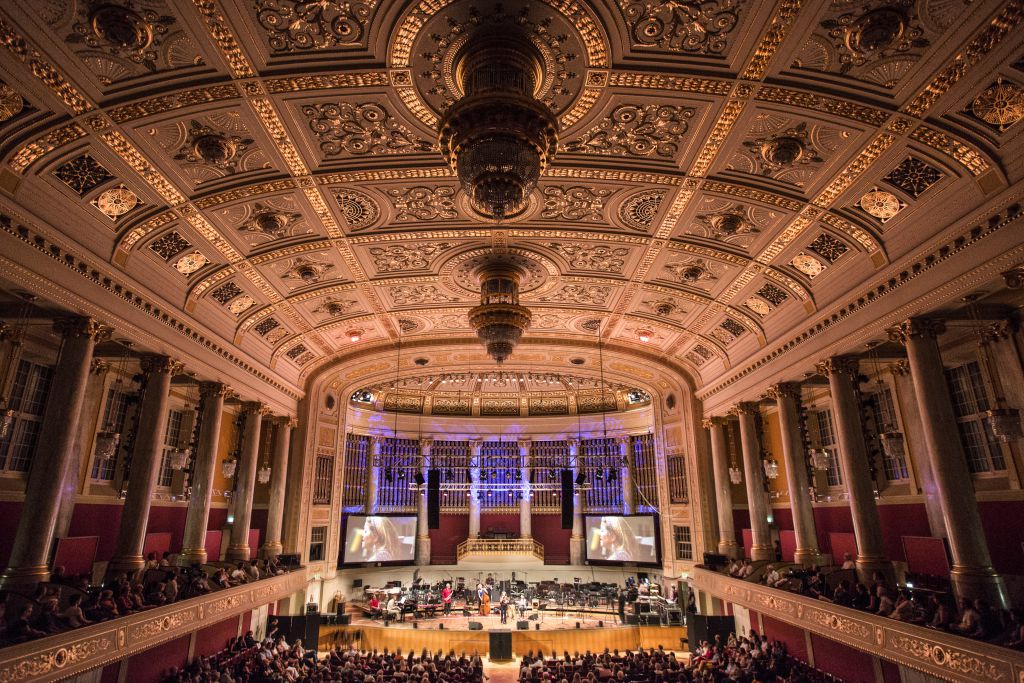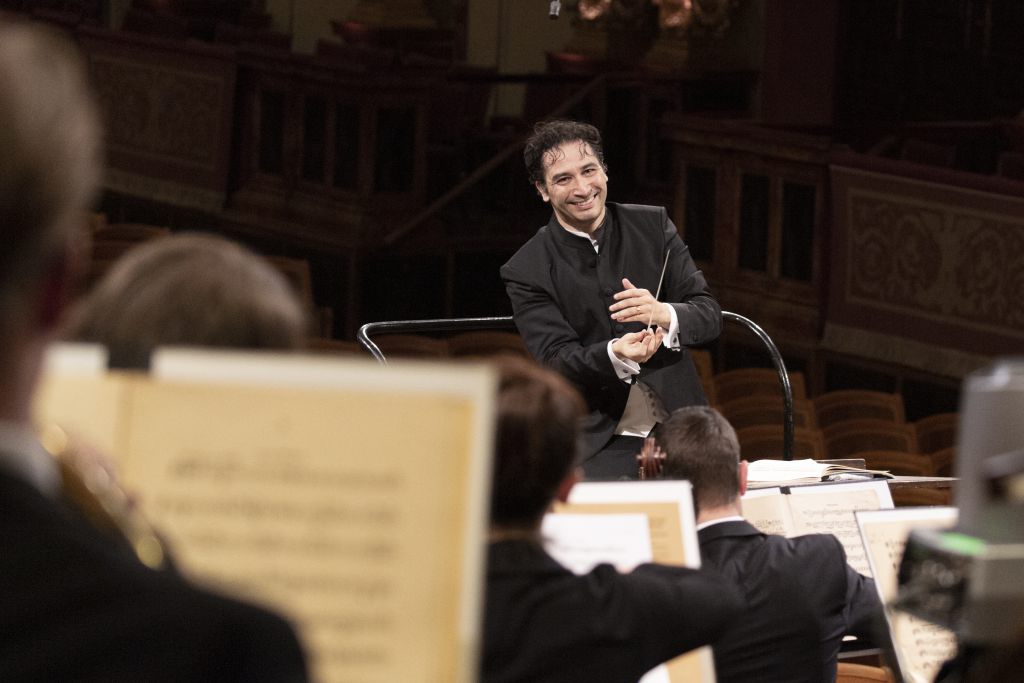Das transdisziplinäre Projekt KlangBildKlang vermittelt zwischen visuellen und musikalischen Erfahrungen
„[…]Und das Ding wird im Kopf wahrlich fast fertig,[…] so dass ich’s hernach mit einem Blick, gleichsam wie ein schönes Bild[…] im Geist übersehe […].“ Als Wolfgang Amadeus Mozart die Art und Weise beschrieb, wie er komponierte, verwendete er den Vergleich mit einem Bild vielleicht nicht ganz von ungefähr. Seine gewaltige schöpferische Vorstellungskraft bleibt unergründlich. Aber der Mensch als hörendes und sehendes Wesen hat schon immer seine Sinne miteinander verbunden und verglichen. Seit der Antike versuchten bildende Künstler_innen auch die Tonkunst in ihren Darstellungen zu erfassen – auch in der gesamten Kunstgeschichte spielt sie eine wichtige Rolle. Allerdings waren manche auch immer wieder um eine Abgrenzung bemüht: Als Ludwig van Beethoven über seine 6. Symphonie („Pastorale“), sagte, diese Musik sei „mehr Ausdruck der Empfindung als Malerei“, wollte er ihre Eigengesetzlichkeit betonen. Umgekehrt wurden besonders im 19. Jahrhundert konkrete Kunstwerke zur Inspiration für Kompositionen.

Modest Mussorgski war bei Weitem nicht der Einzige, der sich von Gemälden und Zeichnungen zu Musik inspirieren ließ – sein Klavierzyklus Bilder einer Ausstellung ist allerdings, nicht zuletzt auch in Form der farbenreichen Orchestrierung von Maurice Ravel, eines der berühmtesten Beispiele für eine solche genreübergreifende Anregung zwischen Malerei und Tonkunst. In der Avantgarde des 20. Jahrhunderts kam es dann ohnehin zu einer umfassenden „Verfransung der Künste“ (Theodor W. Adorno) und in den Umwälzungen der Moderne mit ihrer Revolution der Ausdrucksmittel zu einem vielfach wechselseitigen Austausch zwischen Kunstformen. Für Paul Klee war insbesondere die Musik Johann Sebastian Bachs Impulsgeberin für abstrakte Bilder, Wassily Kandinsky suchte als Synästhetiker (also als jemand, bei dem sich Wahrnehmungen verschiedener Sinne miteinander verbinden) systematisch nach einem Ausdruck für die Farben von Klängen – und tauschte sich intensiv mit Arnold Schönberg aus, der seinerseits zeitweise als Maler tätig war.
Das Projekt KlangBildKlang, das im Mai und Juni mehr als 50 Projekte an verschiedenen Wiener Orten bündelt, kann sich also auf eine reiche musik- und kunstgeschichtliche Tradition berufen. Der Frage, ob man Klänge sichtbar machen und umgekehrt Bilder, Farben und Bewegung hören kann, soll dabei an einer Vielzahl von Orten nachgegangen werden: unter anderem im Haus der Musik, im Künstlerhaus und im Kunst Haus Wien sowie in den städtischen Musikschulen und Volkshochschulen – unter anderem in Zusammenarbeit mit dem Verein Superar oder dem Gesundheits- und Sozialzentrum Cape 10. Dabei wird mit vielfältigen künstlerischen Ansätzen auf ein denkbar breites Publikum ebenso abgezielt wie auf „vielfarbige, diverse und transdisziplinäre Akzente im urbanen Raum“.
Einer der Höhepunkte wird Ende Juni ein Orchesterkonzert mit dem Webern Symphonie Orchester unter der Leitung von Andrés Orozco-Estrada im Wiener Konzerthaus sein – einschließlich öffentlicher Probe und Musizierworkshop. Annegret Huber, Leiterin des Instituts für Kompositionsstudien, Ton- und Musikproduktion, hat im Vorfeld einen Kompositionswettbewerb ins Leben gerufen. Wolfgang Suppan, stellvertretender Leiter des Instituts, sagt dazu: „Wir freuen uns sehr, dass unsere Studierenden mit ihrer Beteiligung am Projekt KlangBildKlang die Möglichkeit erhalten, ihre Konzepte für Orchester und Video-Projektion in einem so prominenten Rahmen vor Publikum im großen Saal umsetzen und dadurch wichtige praktische Erfahrungen im Schreiben für großes Orchester sammeln können. Durch die Kooperation mit Studierenden der FH St. Pölten werden die einzelnen Teams individuelle Ansätze zeigen, wie Musik und Bild sich gegenseitig durchdringen und ergänzen können.“ Durch diese Zusammenarbeit mit zwölf Studierenden des Masterstudiengangs Digital Design (Klasse von Markus Wintersberger) soll die Verzweigung von Klang mit bildlichen Darstellungen noch eindringlicher hervorgehoben und betont werden.
Die willkommene Einbindung des kreativen Potenzials der mdw – Universität für Musik und darstellende Kunst Wien durch das Projekt KlangBildKlang ist eine große Freude und Chance für alle Beteiligten.
Matthias Naske, Intendant des Wiener Konzerthauses
Das Gesamtkonzept des Projekts passt zu einem zentralen Anliegen des Wiener Konzerthaus, möglichst vielen Menschen Musik zugänglich zu machen. Am 21. und 22. Juni erhalten Schüler_innen, Familien sowie Interessierte aller Altersstufen die Möglichkeit, selbst synästhetische Erfahrungen zu sammeln: „Unser Publikum ist an beiden Tagen dazu eingeladen, der individuellen Kreativität freien Lauf zu lassen und dabei das Haus in seiner Vielfalt kennenzulernen“, heißt es dazu aus dem Konzerthaus. Intendant Matthias Naske ergänzt: „Das Wiener Konzerthaus trägt mit seiner künstlerisch offenen und zugleich exzellenzorientierten Programmierung wesentlich zur Lebendigkeit des kulturellen Lebens dieser Stadt bei und strahlt dabei weit über das Land hinaus. Die willkommene Einbindung des kreativen Potenzials der mdw – Universität für Musik und darstellende Kunst Wien durch das Projekt KlangBildKlang ist eine große Freude und Chance für alle Beteiligten. Türen auf für die wunderbaren Musiker_innen der mdw!“
Ich freue mich sehr auf dieses Projekt mit dem Webern Symphonie Orchester, bei dem auch unsere jungen Kolleg_innen neue Wege ausprobieren.
Andrés Orozco-Estrada, Dirigent und Lehrender am Institut für Musikleitung
„Türen auf“ heißt es im Wiener Konzerthaus diesmal aber auch für schillernde visuelle Eindrücke. Denn zu sehen sind während des Mussorgski-Zyklus jene Bilder, die Wassily Kandinsky 1928 für eine szenische Aufführung schuf. Auch bei den Beiträgen, die im Rahmen des Kompositionswettbewerbs entstanden sind, wird es einiges zu sehen geben: Yeison Buitrago ließ sich für sein Stück Das grüne Wunder vom organischen Wachsen in der Natur vom Samen zum Baum und von den einzelnen Bäumen zum Wald inspirieren; Carl Tertio Druml bezieht sich in Tempus Tempestatis sowohl auf die bildende Kunst Anselm Kiefers, in der vielfach (Natur-)Materialien Verwendung finden, als auch auf Wetterphänomene im Gebirge zwischen heiler Welt und Gewitter; Sang Hyun Hong verbindet in Reading Kandinsky Punkte, Linien und Flächen zu einem komplexen Gebilde; und Seoyoon Jang möchte in pebbles, bubbles, rumbles (etwa: „Kieselsteine, (Seifen-)Blasen, Donner/Grollen“) runden Formen von Dingen und auch „runden“ klanglichen Phänomenen nachgehen. Welche zwei Kompositionen audiovisuell uraufgeführt werden, wird von den Studierenden der mdw und der FH St. Pölten im Kollektiv und untereinander im laufenden kreativen Austausch entschieden. Das Abschlusskonzert verspricht so oder so ein einmaliges Erlebnis für Augen und Ohren zu werden.

Dirigent Andrés Orozco-Estrada, selbst Absolvent der mdw und heute Professor für Orchesterdirigieren, Chefdirigent des Orchestra Sinfonica Nazionale della Rai sowie designierter Generalmusikdirektor der Stadt Köln und Gürzenich-Kapellmeister (ab der Saison 2025/26) sagt über das Projekt und seine Probenarbeit: „Es kann schon passieren, dass ich mir Bilder zur Musik vorstelle, aber eher im Bereich der Vorbereitung und der Proben. Bei Mussorgski kennen wir die Bilder, die ihn inspiriert haben – bzw. diejenigen, die davon überliefert sind. Ravel hat in seiner Orchestrierung Mussorgskis Musik nochmals stilistisch weiterentwickelt und dem russischen Ton einen französischen Klang hinzugefügt. Ich freue mich sehr auf dieses Projekt mit dem Webern Symphonie Orchester, bei dem auch unsere jungen Kolleg_innen neue Wege ausprobieren. Da bin ich sehr gerne mit dabei!“
Veranstaltungstipp
Concertino: KlangBildKlang
22. Juni, 15.30 Uhr
Großer Saal, Wiener Konzerthaus

